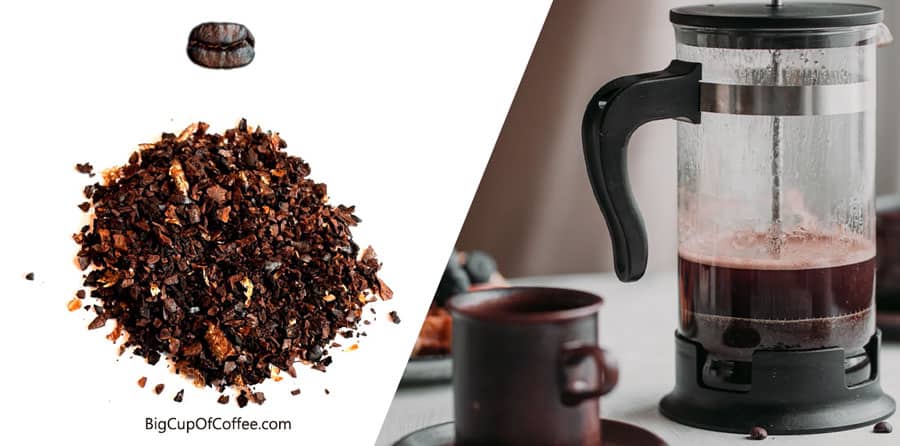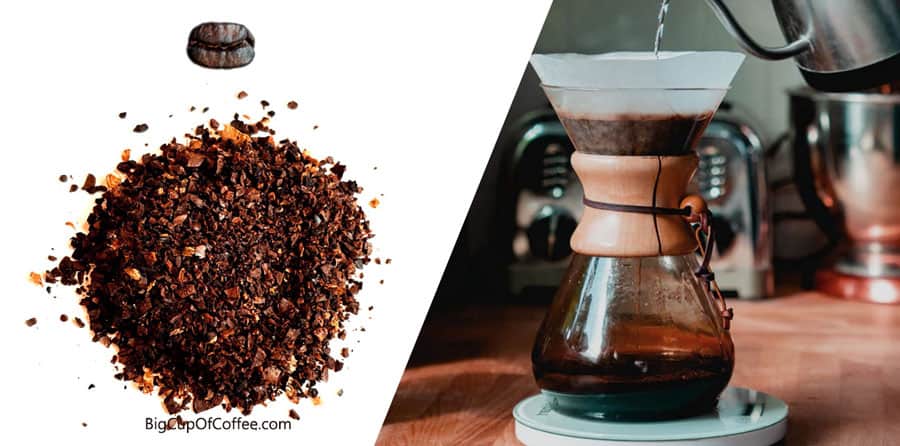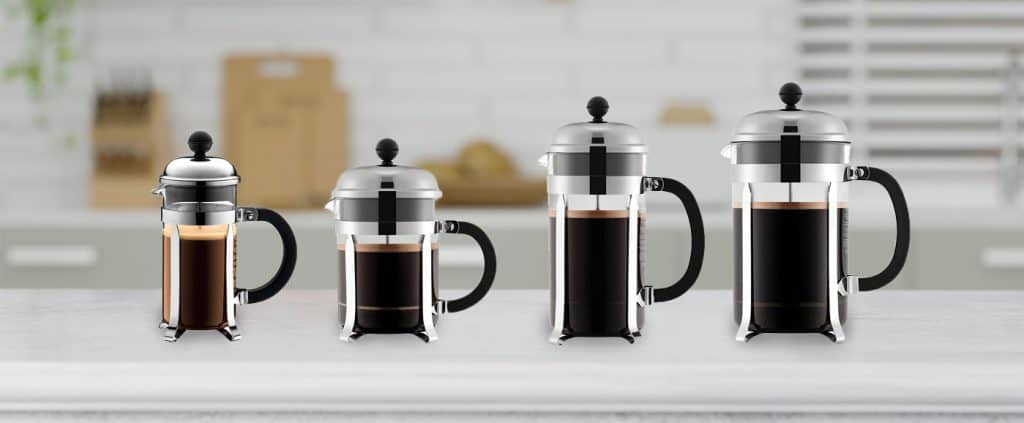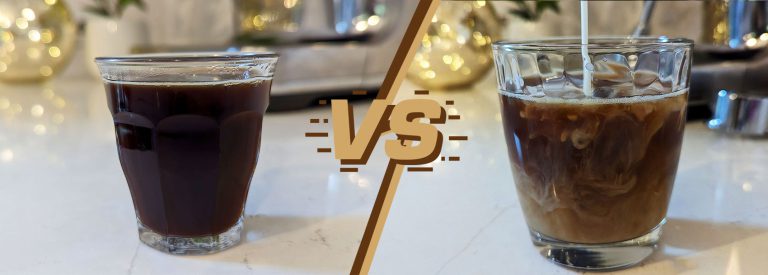French Press vs Chemex: Brewing Showdown – A Barista’s Analysis
The French press and Chemex are two of the coffee brewers that I really appreciate due to their classic styles. But setting that aside, I can’t help but ask, which one’s better?
This led me to write this in-depth comparison of these two iconic brewing methods. In this article, I’ll discuss the different features of both coffee makers that you’d want to consider when choosing the one that suits your taste and lifestyle best.
Let’s get brewing.
Comparing French Press & Chemex – Which Method is Better?
So, which is better, the French Press or Chemex? It depends on what you’re looking for in your coffee.


The French Press is a simple and effective way to make coffee. You start by adding coarsely ground coffee beans to the cylindrical container. Then, you add hot water and let it steep for a few minutes, during which the coffee grounds release their flavors into the water. After steeping, you then press down on the plunger which separates the brewed coffee from the grounds.
Meanwhile, Chemex is a popular pour over brewer that uses an hourglass-shaped glass vessel to make coffee. Here is a complete review of it, including the movies you might have seen the Chemex in 🙂 A paper filter sits on the top half of the brewer, and coffee grounds are placed before you pour hot water into it. The resulting drink then drips on the lower half of the device.
Here are the factors to consider when picking between the two brewing methods, followed by a detailed comparison of each feature.
| Features | French Press | Chemex |
|---|---|---|
| Taste & Flavor | Full-bodied, robust flavors | Clean, light body with a hint of sweetness |
| Strength | Stronger due to more oils and sediments | Medium-strength intensity |
| Ease of Use | Relatively straightforward and simple | Requires practice for pouring technique and timings |
| Brewing Speed | 6-7 minutes | 5-7 minutes |
| Versatility | Limited to hot coffee beverages | Offers control for customized cups of coffee |
| Durability & Portability | Stainless steel options for durability | Glass construction, delicate and not highly portable |
| Sustainability | Environmentally sustainable, no paper waste | Environmentally sustainable, compostable filters |
| Cost | More affordable with no ongoing costs | Reasonable initial cost but with ongoing cost for filters |
Taste, Flavor, & Strength
Starting off with flavor and strength, French Press produces a full-bodied cup of coffee with robust flavors that depend on the type of beans used. The immersion brewing technique results in the final cup having a heavier body on top of its strength.
On the other hand, Chemex uses thicker filters that give your cup of coffee a clean and light body with a hint of sweetness. It produces a clean-tasting cup with medium-strength intensity. Unlike the immersion method used by the French Press, Chemex allows for precise extraction due to its unique paper filtration system.
In terms of coffee strength, both methods can produce a strong cup depending on how much ground coffee you use per serving. Generally speaking though, French press coffee is stronger than Chemex because more oils and sediments get through its metal mesh filtration system.
Personally, I prefer Chemex over French Press because I enjoy my coffee with a cleaner taste without sacrificing flavor. The rich aroma and subtle sweetness are also a plus for me. That said, if you’re looking for a fuller-bodied brew, then French Press coffee just might be perfect for you.
Ease of Use
Now let’s discuss how easy these brewers are to use. The French press is relatively straightforward to use: simply immerse the ground coffee in hot water and press down the plunger to keep the grinds at the bottom while you pour your coffee. It requires a medium-coarse to coarse grind size and 195°F to 205°F (91°C to 96°C) water temperature.

On the other hand, although not difficult, getting the timings right and perfecting your pouring method may require some practice when using a Chemex. After folding the Chemex paper filter correctly, you have to measure and grind medium-coarse coffee, a 200°F water temperature, and a gooseneck kettle for pouring precision. Getting a specialty coffee scale for your Chemex is also needed.

Overall, if we’re talking about which one is easier to use without any prior knowledge or practice needed then the French Press wins due to its simplicity compared to the Chemex.
Brewing Speed
Which method brews faster, you ask? The French Press takes 6 to 7 minutes from grinding to brewing and cleaning up, while the Chemex can be a bit quicker at 5 to 7 minutes. The fact that the French press needs to be preheated, and you need to disassemble it to clean up makes this method longer in total.
Meanwhile, the Chemex also needs careful handling when it’s being washed because of its glass material, but it doesn’t need any disassembling so it is generally faster to clean.
So if you’re always looking for a quick dose of caffeine, the Chemex comes out on top in comparison to the French press. Ultimately, it comes down to personal preference and what factors are most important to you in your coffee-making routine.
Versatility
As a barista, versatility is an essential characteristic of any brewing method for me. It allows you to experiment with different coffee beans and brew styles, catering to diverse moods or occasions.
When comparing the French Press and Chemex brewing methods’ versatility, there’s no denying that the latter has the edge. While the French press can only make hot coffee beverages, Chemex offers more control over the extraction process.
In terms of capacity, both brewers seem to have equal footing. The French press has four size options you can choose from:
- 3-cup (0.35 L)
- 4-cup (0.5 L)
- 8-cup (1 L)
- 12-cup (1.5 L)

Similarly, Chemex comes in four sizes, catering to everyone from solo drinkers to small group gatherings:
- 3-cup (16 oz)
- 6-cup (30 oz)
- 8-cup (40 oz)
- 10-cup (50 oz)

In terms of versatility, Chemex has the upper hand, while the contest of the capacities of both brewers can be deemed a draw. For me, this gives the Chemex a lead overall, because I personally love a drink that I tweaked to my specific preference. Am I a control freak? Hmmm…
Durability and Portability
Now onto durability, the common glass material of the French press can be fragile. But you do have stainless steel options that you can bring around with you without the worry of it breaking inside your bag. So it’s really up to you if you want the classic glass or the more durable steel Fench press.
Chemex loses in this category though, because despite using heat-resistant, shatterproof borosilicate glass that offers better durability than regular glass, it’s still rather delicate. This is also the issue in terms of portability, because while it’s lightweight, the Chemex can easily turn into glass shards in your bag if not handled carefully.
So if you expect your brewer to be a constant companion when you’re out and about, then a stainless steel French press is your best bet.
Sustainability
Sustainability in coffee is vital, as it ensures the longevity of our planet and future generations’ access to this delicious beverage we call coffee.
Besides being an excellent option for taste and ease of use, the French press is also environmentally sustainable. This manual brewer does not use electricity and paper filters that can turn into additional waste. Additionally, French presses are generally made with glass and steel bodies that are recyclable, unlike plastic.
Chemex’s all-glass construction and wooden collar also make it an extremely eco-friendly brewing method. You can further make this sustainable by using reusable filters made with metal and cloth. If you do choose to use Chemex paper filters, they are compostable, helping alleviate the waste single-use filters produce.
Both the French press and Chemex boast eco-friendly brewing, but the French press is naturally more sustainable having a built-in filter.
If you want to explore more ways to make your coffee even more eco-friendly, you might want to use shade-grown coffee and recycle your used coffee grounds.
Cost
Finally, we have the cost of the brewers to consider. The French Press can be affordable, ranging from around $20 for a basic model all the way up to over $100 for larger or more advanced options made with higher-quality materials. Once you make your initial purchase, there are no additional operating expenses required.
As for the Chemex, the prices are reasonable ranging from about $40 to $100. This may seem like a decent deal but you should also consider the added cost of single-use paper filters at around $0.08 in 2025.
So which option is more affordable? The economical choice that won’t require any ongoing costs is the French press.
French Press and Chemex – Weighing the Pros & Cons
Now that we’ve gotten a closer look at the features of each brewing method, here’s a quick overview of the pros and cons of French press and Chemex so you can finally decide which one is for you:
| Brewing Method | Pros | Cons |
|---|---|---|
| French Press | – Easy to use – The glass material offers decent heat retention – Stainless steel models offer durability | – Some sediments may get into your drink – Common glass build is prone to breakage |
| Chemex | – A wide range of sizes and capacity – A clean and light cup of coffee – Attractive aesthetic | – The glass design can be fragile – Requires some learning curve – Relatively expensive compared to other pour-over brewers |
If you’re wondering how French press also compares to other brewers, check out my comparisons below:
Meanwhile, here are my comparisons between Chemex and other brewing methods:
Conclusion
There you go, an in-depth look at the French press and Chemex. Both have their advantages and drawbacks, so the better brewer is really up to your preference. If you like a simple yet effective way to brew a cup of joe, then you should go for the French press. But if you prefer a cleaner and lighter coffee that you can customize, the Chemex is worth considering.
As for me, I like the Chemex better. Sure, there’s a bit of a learning curve involved in using this pour over brewer, but once you get the hang of it, it’s a breeze brewing consistently good coffee that suits your palate.
How about you, which brewer do you prefer? Share it in the comments below.







